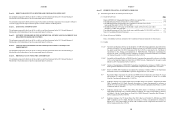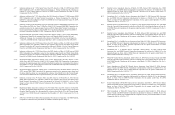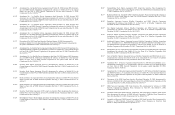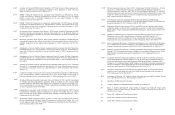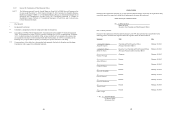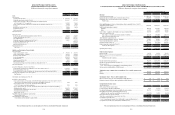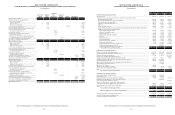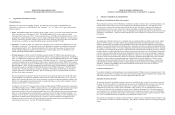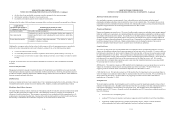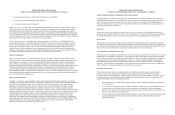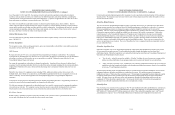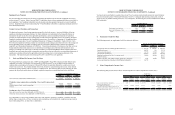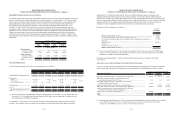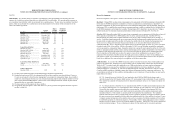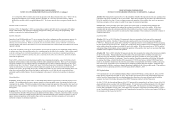Dish Network 2012 Annual Report Download - page 59
Download and view the complete annual report
Please find page 59 of the 2012 Dish Network annual report below. You can navigate through the pages in the report by either clicking on the pages listed below, or by using the keyword search tool below to find specific information within the annual report.DISH NETWORK CORPORATION
NOTES TO CONSOLIDATED FINANCIAL STATEMENTS
1. Organization and Business Activities
Principal Business
DISH Network Corporation is a holding company. Its subsidiaries (which together with DISH Network
Corporation are referred to as “DISH Network,” the “Company,” “we,” “us” and/or “our”) operate three primary
business segments.
x DISH. The DISH® branded direct broadcast satellite (“DBS”) pay-TV service had 14.056 million subscribers
in the United States as of December 31, 2012. The DISH branded pay-TV service consists of Federal
Communications Commission (“FCC”) licenses authorizing us to use DBS and Fixed Satellite Service (“FSS”)
spectrum, our owned and leased satellites, receiver systems, third-party broadcast operations, customer service
facilities, a leased fiber network, in-home service and call center operations, and certain other assets utilized in
our operations. In addition, we market broadband services under the dishNET™ brand.
x Blockbuster. On April 26, 2011, we completed the acquisition of most of the assets of Blockbuster, Inc. (the
“Blockbuster Acquisition”). The financial results of our Blockbuster operations are included in our financial
results beginning April 26, 2011. Blockbuster primarily offers movies and video games for sale and rental
through multiple distribution channels such as retail stores, by-mail, digital devices, the blockbuster.com
website and the BLOCKBUSTER On Demand® service.
x Wireless Spectrum. In 2008, we paid $712 million to acquire certain 700 MHz wireless spectrum licenses,
which were granted to us by the FCC in February 2009 subject to certain build-out requirements. On March 9,
2012, we completed the acquisitions of 100% of the equity of reorganized DBSD North America, Inc. (“DBSD
North America”) and substantially all of the assets of TerreStar Networks, Inc. (“TerreStar”), pursuant to which
we acquired, among other things, 40 MHz of 2 GHz wireless spectrum licenses held by DBSD North America
and TerreStar. The financial results of DBSD North America and TerreStar are included in our financial results
beginning March 9, 2012. The total consideration to acquire these assets was approximately $2.860 billion.
This amount includes $1.364 billion for DBSD North America (the “DBSD Transaction”), $1.382 billion for
TerreStar (the “TerreStar Transaction”), and the net payment of $114 million to Sprint Nextel Corporation
(“Sprint”) pursuant to a settlement agreement. We are evaluating our options to commercialize these assets.
See Note 10 for further information.
We currently generate an immaterial amount of revenue and incur operating expenses associated with certain
satellite operations and regulatory compliance matters from our wireless spectrum assets. As we review our
options for the commercialization of this wireless spectrum, we may incur significant additional expenses and
may have to make significant investments related to, among other things, research and development, wireless
testing and construction of a wireless network.
On March 21, 2012, the FCC released a Notice of Proposed Rulemaking (“NPRM”) proposing the elimination
of the Mobile-Satellite Service (“MSS”) “integrated service,” spare satellite and various technical requirements
attached to the 2 GHz licenses. On December 12, 2012, the FCC approved rules that eliminated these
requirements and gave notice of its proposed modification of our 2 GHz authorizations to, among other things,
allow us to offer single-mode terrestrial terminals to customers who do not desire satellite functionality. On
February 15, 2013, the FCC issued an order, which will become effective on March 7, 2013, modifying our 2
GHz licenses to add terrestrial operating authority. The FCC’s order of modification has imposed certain
limitations on the use of a portion of the spectrum and also mandated certain interim and final build-out
requirements for the licenses. See Note 10 for further information.
F-8
DISH NETWORK CORPORATION
NOTES TO CONSOLIDATED FINANCIAL STATEMENTS - Continued
2. Summary of Significant Accounting Policies
Principles of Consolidation and Basis of Presentation
We consolidate all majority owned subsidiaries, investments in entities in which we have controlling influence and
variable interest entities where we have been determined to be the primary beneficiary. Non-majority owned
investments are accounted for using the equity method when we have the ability to significantly influence the
operating decisions of the investee. When we do not have the ability to significantly influence the operating
decisions of an investee, the cost method is used. All significant intercompany accounts and transactions have been
eliminated in consolidation. Certain prior period amounts have been reclassified to conform to the current period
presentation.
Use of Estimates
The preparation of financial statements in conformity with accounting principles generally accepted in the United
States (“GAAP”) requires us to make estimates and assumptions that affect the reported amounts of assets and
liabilities and disclosure of contingent assets and liabilities at the date of the financial statements and the reported
amounts of revenue and expense for each reporting period. Estimates are used in accounting for, among other things,
allowances for doubtful accounts, self-insurance obligations, deferred taxes and related valuation allowances, uncertain
tax positions, loss contingencies, the useful lives and residual value surrounding our rental library inventory, estimated
accruals related to revenue-sharing titles that are subject to performance guarantees, fair value of financial instruments,
fair value of options granted under our stock-based compensation plans, fair value of assets and liabilities acquired in
business combinations, fair value of multi-element arrangements, capital leases, asset impairments, estimates of future
cash flows used to evaluate impairments, useful lives of property, equipment and intangible assets, asset retirement
obligations, retailer incentives, programming expenses, subscriber lives and royalty obligations. Weak economic
conditions have increased the inherent uncertainty in the estimates and assumptions indicated above. Actual results
may differ from previously estimated amounts, and such differences may be material to the Consolidated Financial
Statements. Estimates and assumptions are reviewed periodically, and the effects of revisions are reflected
prospectively in the period they occur.
Cash and Cash Equivalents
We consider all liquid investments purchased with an original maturity of 90 days or less to be cash equivalents. Cash
equivalents as of December 31, 2012 and 2011 may consist of money market funds, government bonds, corporate notes
and commercial paper. The cost of these investments approximates their fair value.
Marketable Investment Securities
We currently classify all marketable investment securities as available-for-sale, except for investments accounted
for under the fair value method. We adjust the carrying value of our available-for-sale securities to fair value and
report the related temporary unrealized gains and losses as a separate component of “Accumulated other
comprehensive income (loss)” within “Total stockholders’ equity (deficit),” net of related deferred income tax.
Declines in the fair value of a marketable investment security which are determined to be “other-than-temporary”
are recognized in the Consolidated Statements of Operations and Comprehensive Income (Loss), thus establishing a
new cost basis for such investment. All changes to our securities accounted for at fair value are reflected in “Other,
net” in the Consolidated Statements of Operations and Comprehensive Income (Loss).
We evaluate our marketable investment securities portfolio on a quarterly basis to determine whether declines in the
fair value of these securities are other-than-temporary. This quarterly evaluation consists of reviewing, among other
things:
F-9



